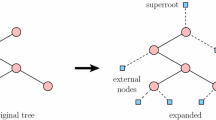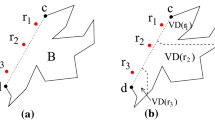Abstract
We consider the following four problems for a setS ofk points on a plane, equipped with the rectilinear metric and containing a setR ofn disjoint rectangular obstacles (so that distance is measured by a shortest rectilinear path avoiding obstacles inR): (a) find aclosest pair of points inS, (b) find anearest neighbor for each point inS, (c) compute the rectilinearVoronoi diagram ofS, and (d) compute a rectilinearminimal spanning tree ofS. We describeO ((n+k) log(n+k))-time sequential algorithms for (a) and (b) based onplane-sweep, and the consideration of geometrically special types of shortest paths, so-calledz-first paths. For (c) we present anO ((n+k) log(n+k) logn)-time sequential algorithm that implements a sophisticateddivide-and-conquer scheme with an addedextension phase. In the extension phase of this scheme we introduce novel geometric structures, in particular so-calledz-diagrams, and techniques associated with the Voronoi diagram. Problem (d) can be reduced to (c) and solved inO ((n+k) log(n+k) logn) time as well. All our algorithms arenear-optimal, as well as easy to implement.
Similar content being viewed by others
References
B. Aronov, On the geodesic Voronoi diagram of point sites in a simple polygon,Algorithmica 4 (1989), 109–140.
M. J. Atallah, D. Chen, Parallel rectilinear shortest paths with rectangular obstacles,Proc. ACM Symp. on Parallel Algorithms and Architectures, 1990, pp. 270–279. Also inComput. Geom. Theory Appl. 1 (1991), 79–113.
J. L. Bentley, M. I. Shamos, Divide-and-conquer in multidimensional space,Proc. ACM Symp. on Theory of Computing, 1976, pp. 220–230.
D. Cheriton, R. E. Tarjan, Finding minimum spanning trees,SIAM J. Comput. 5 (1976), 724–742.
K. L. Clarkson, S. Kapoor, P. M. Vaidya, Rectilinear shortest paths through polygonal obstacles inO(n(logn)2) time,Proc. ACM Symp. on Computational Geometry, 1987, pp. 251–257.
P. J. de Rezende, D. T. Lee, Y. F. Wu, Rectilinear shortest paths with rectangular barriers,Proc. ACM Symp. on Computational Geometry, 1985, pp. 204–213. Also inDiscrete Comput. Geom. 4 (1989), 41–53.
D. Dobkin, R. Lipton, On the complexity of computations under varying sets of primitives,J. Comput. System. Sci. 18 (1979), 86–91.
S. Guha, Parallel Algorithms for Polygonal and Rectilinear Geometry, Ph.D. Thesis, Computer Science and Engineering, University of Michigan, Ann Arbor, MI, 1991.
L. Guibas, J. Hershberger, D. Leven, M. Sharir R. Tarjan, Linear-time algorithms for visibility and shortest path problems inside a triangulated simple polygons,Algorithmica 2 (1987), 209–233.
D. G. Kirkpatrick, Optimal search in planar subdivision,SIAM J. Comput. 12 (1983), 28–35.
R. C. Larson, V. O. Li, Finding minimum rectilinear distance paths in the presence of barriers,Networks 11 (1981), 285–304.
D. T. Lee, Two-dimensional Voronoi diagrams in theL p -metric,J. Assoc. Comput. Mach. 27 (1980), 604–618.
D. T. Lee, C. D. Yang, T. H. Chen, Shortest rectilinear paths among weighted obstacles,Internat. J. Comput. Geom. Appl. 1 (1991), 109–204.
J. S. B. Mitchell,L 1 shortest paths among polygonal obstacles in the plane,Algorithmica 8 (1992), 55–88.
F. P. Prearata, M. I. Shamos,Computational Geometry: An Introduction, Springer-Verlag, New York, 1985.
M. I. Shamos, D. Hoey, Closest-point problems,Proc. IEEE Symp. on Foundations of Computer Science, 1975, pp. 151–162.
P. Widmayer, Y. F. Wu, C. K. Wong, On some distance problems in fixed orientations,SIAM J. Comput. 16 (1987), 728–246.
Y. F. Wu, P. Widmayer, M. D. F. Schlag, C. K. Wong, Rectilinear shortest paths and minimum spanning trees in the presence of rectilinear obstacles,IEEE Trans. Comput. 36 (1987), 321–331.
C. D. Yang, D. T. Lee, C. K. Wong, On bends and lengths of rectilinear paths: a graph-theoretic approach,Internat. J. Comput. Geom. Appl. 2 (1992), 61–74.
Author information
Authors and Affiliations
Additional information
Communicated by D. T. Lee.
An extended abstract appeared inProc. 13th Conf. on the Foundations of Software Technology and Theoretical Computer Science, Bombay, 1993, Springer-Verlag, pp. 218–227. Sumanta Guha was supported in part by a UW-Milwaukee Graduate School Research Committee Award. Ichiro Suzuki was supported in part by the National Science Foundation under Grants CCR-9004346 and IRI-9307506, the Office of Naval Research under Grant N00014-94-1-0284, and an endowed chair supported by Hitachi Ltd. at the Faculty of Engineering Science, Osaka University.
Rights and permissions
About this article
Cite this article
Guha, S., Suzuki, I. Proximity problems for points on a rectilinear plane with rectangular obstacles. Algorithmica 17, 281–307 (1997). https://doi.org/10.1007/BF02523193
Received:
Revised:
Issue Date:
DOI: https://doi.org/10.1007/BF02523193




